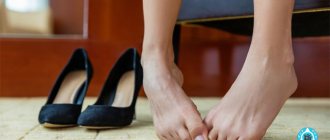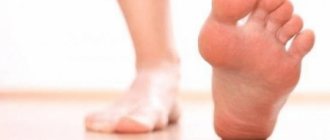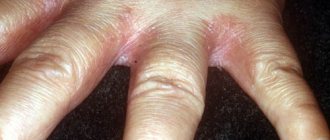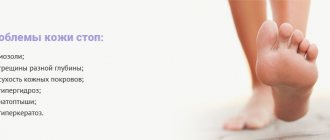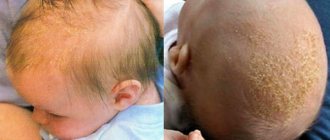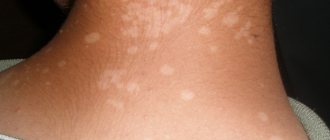Improper care
The skin on children's legs is extremely sensitive to negative influences. Dryness and flaking are often provoked by simply washing your feet with running water. For example, when the water is hard or contains a lot of chlorine. Therefore, after bathing procedures, be sure to apply a moisturizing, nourishing cream or baby oil to your feet. If possible, buy a special filter nozzle for the shower that will retain chlorine and mechanical impurities. This will prevent irritation and protect the baby’s skin from drying out. Prolonged bathing in hot water is also bad.
If the skin of a child's feet is peeling, the reason may be tight, artificial shoes, synthetic tights, or socks. When in contact with such materials, the skin “does not breathe” and sweats, which leads to peeling. The area between the toes is most affected.
Dry air has a negative effect on delicate baby skin. Many mothers notice that it is in winter, when there are hot radiators in the apartment, that the child’s palms and feet become very flaky.
You can solve the problem if:
- use moisturizer daily;
- regularly ventilate the apartment or house;
- maintain humidity within 40 - 60% using a humidifier or improvised means (wet towels, radiator sheets).
For intensive hydration and restoration of children's skin, ointments with provitamin B5 - Bepanten, Dexpanthenol - help.
Why does skin peel off between my child’s fingers?
There are quite a few reasons that can cause this unpleasant symptom.
Below are the main ones:
- Fungal infection of the skin, as well as various skin infections, for example, herpes zoster;
- Allergic reactions;
- Diabetes mellitus and other endocrine diseases;
- Too dry air can also provoke a similar condition - this situation is usually observed in the winter season, when heating devices are constantly turned on in apartments;
- Low-quality shoes made from artificial materials;
- Using too aggressive or age-inappropriate cosmetics;
- Poor nutrition, vitamin deficiency;
- Shoes that are too warm, causing your feet to sweat when worn;
- Nervous stress and mental stress;
- Prolonged exposure to chlorinated water - this situation is quite often observed in children who swim and regularly visit the pool.
Peeling of the skin between the toes is most often observed on the feet. If this unpleasant symptom is provoked by reasons such as allergies, fungus or other dermatological diseases, it can be detected, including on the hands.
Allergy
Peeling of the skin on a child’s feet is possible due to allergic reactions, atopic or contact dermatitis.
Irritation is caused by:
- washing powder that you use to wash children's socks or tights;
- baby creams, care oils;
- clothing made from synthetic fabrics;
- highly allergenic foods (citrus fruits, milk, chocolate, eggs, fish);
- insect bites;
- medicines, sweet syrups containing chemical flavors, dyes, flavoring additives.
Allergic reactions are often accompanied by severe itching. Parents should ensure that the child does not scratch the skin, otherwise an infection will occur. Antihistamines help cope with itching, redness, and inflammation. For effective treatment, it is important to identify and eliminate the allergen.
Why is this happening
Peeling skin in a child is not uncommon. In childhood, the thickness of the skin is 1.5-3 times less than in an adult. The stratum corneum is also thinner. The structure of the skin itself is loose, which makes it more extensible (a necessary property during active growth).
But the downside of skin extensibility is insufficient keratinization of the stratum corneum, which performs the protective functions of the body. As a result, the child's skin is easily vulnerable and prone to inflammation and peeling.
Treating with ointments without a doctor’s prescription is dangerous
In childhood, the skin participates in the respiratory functions of a child to a greater extent than in an adult. Let’s also remember about the increased blood supply to the child’s skin and the general sensitivity of the child’s skin.
Ointments have a cumulative effect, and it is impossible to say exactly how the use of a number of medications will affect the child’s health in the future. Let us remind you once again - do not self-diagnose or self-medicate.
The only universal recommendation
Often the cause of peeling lies in household irritants (chemicals, plasticine, slimes, paints, household soap, PVA glue). If you notice peeling in your child, along with making an appointment with the doctor, limit your child's contact with the sources described above.
But it is important to understand that limiting contact with possible irritants alone in the treatment of “advanced pathology” is not enough - the skin barrier is already broken and requires restoration (including using physiotherapy).
Fungal infection
If your child likes to try on other people's shoes, walks barefoot in public places or goes to the pool, there is a risk that he has contracted a fungus.
In addition to peeling, this infection is characterized by the following changes in the affected area:
- itching;
- redness, inflammation;
- unpleasant odor;
- thickening of the skin;
- formation of microcracks.
It often happens that peeling is the only symptom. Parents may not suspect that it is a fungus. The skin between the toes usually suffers first, and then, if left untreated, the infection progresses.
To combat the fungus, antifungal agents are used, which are recommended by a dermatologist, mycologist or podologist. The sooner treatment is started, the easier and faster it is to get rid of the infection.
Antifungal agents
Antifungal ointments are prescribed by a doctor when diagnosing fungal infections in a child, which is manifested by the appearance of cracks in the legs. The most commonly used means are:
- "Lamicon" is an active antifungal drug with a wide range of uses, recommended for dermatomycosis and yeast-like fungal infections. Available both in the form of tablets for oral administration and in the form of creams and sprays.
- "Clotrimazole" is an analogue of the drug "Lamicon" and is actively used to combat fungus. Therefore, it will also be indispensable if the skin on the child’s toes cracks.
Lack of vitamins
A deficiency of vitamins A, E and D leads to flaky feet in a child. Children under 5 years of age experience this more often than older children.
To tidy up your skin, adjust your baby's nutrition. Add freshly squeezed carrot, apple juice, nuts, vegetable oils, dairy products. If the skin on the feet and legs of an infant is peeling, the nursing mother should reconsider her diet. For bottle-fed babies, the pediatrician decides in what form it is best to add the missing vitamins. Vitamin complexes from a pharmacy are safe to give only as prescribed by a doctor.
If you have hypovitaminosis, you can try applying vitamins topically, directly to problem areas. To do this, take Aevit capsules, add their contents to a small amount of baby cream, and lubricate your feet after bathing. From pharmaceutical products, dermatologists prescribe Radevit ointment, which contains vitamins A, D, E.
Traditional medicine recipes
After it has been established why the skin on the baby’s toes and heels is cracking, you can, after consulting with your doctor, use folk remedies that will help alleviate the condition:
- Lubricating the damaged areas with onion ointment prepared at home (2 chopped onions are poured with warm vegetable oil, the mixture is brought to a boil, melted beeswax is added, the mixture is cooled and stored in the refrigerator). The treatment period usually lasts 2 weeks.
- Lotions with apple cider vinegar diluted in half with water. They are done using gauze swabs for one hour before bedtime.
- Baths with the addition of infusions of medicinal herbs (chamomile, calendula, sage, thyme, nettle leaves) have an excellent calming and moisturizing effect. The infusion is made based on the proportion: 10 grams of each herb per 2-3 liters of water. Leave for a day and warm up before use. Baths should be given to the child for half an hour every day until the cracks disappear.
- Homemade ointment with the addition of fresh leaves of golden mustache based on Vaseline is an effective remedy when the skin on a child’s toes is cracked. It must be stored in the refrigerator, warmed slightly before use and applied for half an hour.
- Compresses made from simple boiled, crushed potatoes have a good effect in healing cracks. This compress is applied to the damaged areas of the child’s legs for 20 minutes for 10 days.
- Compress made of gauze, generously soaked in liquid honey. It is recommended to use no more than 1 time per day to avoid causing irritation. In addition, care must be taken when using such a compress in children with allergic reactions.
It should be noted once again that the use of the above folk remedies must be agreed upon with the attending dermatologist, since self-medication when solving problems with a child’s health is unacceptable.
Intestinal disorders
The cause of peeling skin on a child's feet is often associated with dysbacteriosis and helminthic infestation. Dysbacteriosis makes it difficult to digest food, and the absorption of vitamins and other substances beneficial to the skin deteriorates. Violation of the intestinal microflora often occurs in infants whose digestive system is not yet fully developed, and in children who have taken antibacterial agents. Probiotics and prebiotics help restore the balance of beneficial and harmful bacteria.
If your feet have been peeling for a long time, it won’t hurt to get tested for helminths. Damage to the body by these parasites negatively affects the condition of the skin, provokes dysbacteriosis, allergies, decreased immunity, and other disorders.
Ointments
Ointments that have a wound-healing effect help in the process of skin regeneration and healing of the cracks themselves. Among the most popular are the following:
- "Bepanten" is a drug with antibacterial and anti-inflammatory effects. It is approved for use even for newborns. It is also prescribed for the prevention of cracked feet in children.
- “Actovegin” is an ointment that has good regenerating properties, helps with the healing of cracks, and quickly renews the skin of the legs.
- “Levomekol” has a strong disinfecting effect, in addition, it has the properties of influencing the child’s immunity, which allows the body to participate in the healing of cracks in the baby’s legs.
- "Solcoseryl" is a unique drug developed based on the blood extract of young calves, which allows you to speed up metabolism.
- Vishnevsky ointment is a drug with many years of use that has proven itself to be an effective wound-healing and anti-inflammatory agent. Helps dry cracks and promote tissue growth.
Skin diseases
Skin problems on the legs can be the result of dermatological diseases or infections.
These include:
- Eczema. A hereditary chronic disease, the development of which is provoked by allergies, reduced immunity, stress, and infections. With eczema on the feet, the skin becomes very dry, itchy, red, and covered in a rash;
- Psoriasis. Chronic non-contagious disease with genetic predisposition. The impetus for the appearance of symptoms can be a change of season, rubbing the skin with clothing, infections, or certain medications. Psoriasis causes scaly, inflamed red patches;
- Lichen. An infectious disease caused by various fungal or viral pathogens. There are 5 types of lichen. Ringworm (microsporia) is usually found in children. Children of preschool age and primary schoolchildren who come into contact with street cats or dogs get sick more often. This type of lichen appears as pink spots with a flaky center.
What to do?
Have you noticed that your child's feet are flaky? Don't rush to the moms' forum for advice. If the condition does not improve after using moisturizing baby cream, consult a doctor. Parents' independent conclusions about the cause of skin changes are often erroneous. And lost time and improper treatment only worsen the situation, leading to cracks and infection. Therefore, be sure to consult a dermatologist.
To prevent peeling, make sure your child has:
- complete balanced nutrition;
- moisturizing foot cream with natural composition;
- strong immunity;
- proper foot hygiene;
- comfortable, natural shoes.
To monitor the condition and prevent foot diseases, we recommend that you and your child undergo periodic examinations by a podiatrist and undergo medical pedicures.
0 0
What should you do if the skin between your child’s fingers peels and peels?
The first thing you should do if you notice a similar symptom in a child is to consult a dermatologist. A qualified doctor will conduct an in-person examination and the necessary examination, after which he will be able to confirm or deny the presence of any skin disease.
- If the baby is diagnosed with a fungal infection of the skin, the doctor will prescribe the necessary treatment, which includes oral administration and local use of various antifungal drugs, for example, Terbizil, Exoderil or Exifin Mycoterbin. In addition, it is necessary to take multivitamins appropriate for the child’s age.
- If other dermatological diseases are detected, the doctor will also prescribe medications to get rid of the underlying disease, as a result of which the unpleasant symptoms will disappear. If your baby does not have any dermatological diseases, you should check your blood sugar. This is especially true in cases where the child has peeling skin between the fingers of not only the toes, but also the hands. If your blood sugar level is elevated, your baby will have to undergo a full examination to confirm or exclude the diagnosis of diabetes mellitus.
- Treatment for this disease must be comprehensive. In addition, maintenance therapy will be necessary throughout the rest of life, since diabetes mellitus, like any other endocrine disease, is not completely cured.
- If the cause of peeling and peeling skin is an allergy, it is necessary to detect the allergen as quickly as possible and, if possible, exclude all contacts of the child with it. To alleviate the baby’s condition and get rid of itching and other unpleasant sensations, he should take antihistamines, such as Fenistil or Zyrtec.
- In all other cases, you can cope with the disease on your own. To do this, you should provide your baby with a nutritious and balanced diet, spend as much time as possible in the fresh air and purchase comfortable shoes made from natural materials. In addition, the child needs to take a course of multivitamin preparations containing a large amount of useful minerals.
Also, your son or daughter’s feet will require appropriate care, namely:
- Before going to bed, the baby's feet should be kept in a salt bath for 15-20 minutes. It is also useful to add a few drops of essential oils to it. Lavender is best suited in this situation, since it can not only alleviate the child’s condition, but also calm him down;
- The skin between the toes, and in some cases the entire foot as a whole, must be carefully treated daily with fine and gentle pumice;
- After carrying out the above procedures, the baby’s feet should be generously smeared with baby cream, then put on cotton socks and go to bed. During the day, on the contrary, it is best to walk barefoot, if the air temperature in the apartment allows it;
- During the entire treatment period and as long as the skin on the arms and legs is still peeling, the use of any shower gels and similar cosmetic products is prohibited. The child should be washed only with laundry or tar soap.
